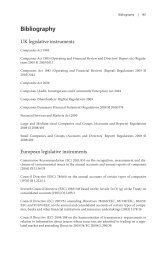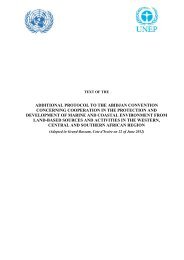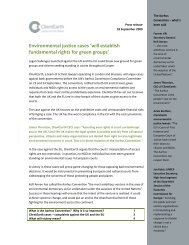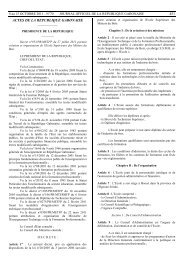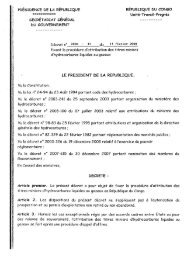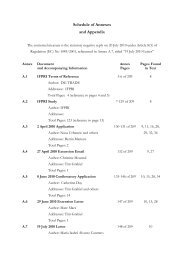Environmental and social transparency under the ... - ClientEarth
Environmental and social transparency under the ... - ClientEarth
Environmental and social transparency under the ... - ClientEarth
- No tags were found...
You also want an ePaper? Increase the reach of your titles
YUMPU automatically turns print PDFs into web optimized ePapers that Google loves.
104 | <strong>Environmental</strong> <strong>and</strong> <strong>social</strong> <strong>transparency</strong> <strong>under</strong> <strong>the</strong> Companies Act 2006Annex 3: EU law on company environmental <strong>and</strong> <strong>social</strong> accounting <strong>and</strong> reporting | 105environmental reporting as part of business reporting. The Recommendation’skey substance is outlined below.Key definitionsHaving delineated its scope, <strong>the</strong> Recommendation outlines a number ofkey definitions. It defines ‘environmental expenditure’, as including <strong>the</strong>costs of steps taken by a company to prevent reduce or repair damage to<strong>the</strong> environment resulting from company activities, including, amongsto<strong>the</strong>rs: <strong>the</strong> disposal <strong>and</strong> avoidance of waste; <strong>the</strong> protection of soil <strong>and</strong> ofsurface water <strong>and</strong> groundwater; <strong>the</strong> protection of clean air <strong>and</strong> climate;noise reduction; <strong>and</strong> <strong>the</strong> protection of biodiversity <strong>and</strong> l<strong>and</strong>scape. Itexcludes costs whose primary purpose is to respond to o<strong>the</strong>r needs (thanto prevent, reduce or repair environmental damage), such as to increaseprofitability, health <strong>and</strong> safety at <strong>the</strong> workplace or production efficiency.It also excludes costs resulting from fines or penalties for noncompliancewith environmental regulation or compensation for past environmentalpollution, which it holds should be accounted separately.Recognition <strong>and</strong> measurementThe Recommendation <strong>the</strong>n sets out a detailed set of guidelines for <strong>the</strong> waythat various issues should be recognised <strong>and</strong> measured in accounting <strong>and</strong>reporting: recognition of environmental liabilities (including contingent<strong>and</strong> offset); recognition of environmental expenditure (including guidanceon capitalisation <strong>and</strong> asset impairment); measurement of environmentalexpenditure (including guidance on site restoration / dismantling costs,<strong>and</strong> discounting of long-term liabilities).DisclosuresFinally, <strong>the</strong> Recommendation sets out <strong>the</strong> environmental issues thatshould be disclosed in various places in <strong>the</strong> reports:- Annual <strong>and</strong> consolidated accounts – Policies <strong>and</strong> programmes adoptedin respect of environmental protection; improvements in key areasof environmental protection; relationship of policies or measures toenvironmental legislation; (where appropriate for size of company)information on environmental performance on energy use, materialsuse, water use, emissions, waste disposals (recommending consistent<strong>and</strong> comparable quantitative eco-efficiency indicators); references toany separate company environmental report.- Balance sheet – <strong>Environmental</strong> liabilities.- Notes to annual <strong>and</strong> consolidated accounts – Valuation methodsapplied; extraordinary environmental expenditures charged to <strong>the</strong>profit <strong>and</strong> loss account; contingent environmental liabilities; descriptionsof each environmental liability (nature, indication of <strong>the</strong> timing<strong>and</strong> terms of settlement, explanation of <strong>the</strong> damage <strong>and</strong> laws or regulationswhich require its remediation, <strong>and</strong> restoring or preventive stepsbeing taken / proposed); undiscounted liability <strong>and</strong> discount rate used;accounting policy regrading long-term restoration / decommissioning/ dismantling costs; amount of environmental expenditure charged toprofit <strong>and</strong> loss account; amount of environmental expenditure capitalised;costs incurred as result of fines <strong>and</strong> penalties for non-compliancewith environmental regulations <strong>and</strong> compensation paid to thirdparties; government incentives related to environmental protectionreceived or entitled to by <strong>the</strong> company.N.B.In <strong>the</strong> Recommendation recitals, 287 <strong>the</strong> Commission stated that:“(4) The lack of explicit rules has contributed to a situation where different stakeholders,including regulatory authorities, investors, financial analysts <strong>and</strong> <strong>the</strong> publicin general may consider <strong>the</strong> environmental information disclosed by companiesto be ei<strong>the</strong>r inadequate or unreliable. Investors need to know how companiesdeal with environmental issues. Regulatory authorities have an interest in monitoring<strong>the</strong> application of environmental regulations <strong>and</strong> <strong>the</strong> associated costs.None<strong>the</strong>less, voluntary disclosure of environmental data in <strong>the</strong> annual accounts<strong>and</strong> annual reports of companies is still running at low levels, even though it isoften perceived that enterprises face increasing environmental costs for pollutionprevention <strong>and</strong> clean-up equipment <strong>and</strong> for waste clean-up <strong>and</strong> monitoringsystems, in particular those enterprises operating in sectors that have significantimpacts on <strong>the</strong> environment.(6) The costs of collecting <strong>and</strong> reporting environmental data <strong>and</strong> <strong>the</strong> sensitivenessor confidentiality that might be associated, in certain cases, with such informationare frequently regarded as deterrent factors for disclosure of environmentalinformation in <strong>the</strong> financial statements of companies. Never<strong>the</strong>less, <strong>the</strong>se argumentsdo not eliminate <strong>the</strong> need to stimulate <strong>the</strong> provision of environmentalinformation. Users of financial statements need information about <strong>the</strong> impactof environmental risks <strong>and</strong> liabilities on <strong>the</strong> financial position of <strong>the</strong> company,






